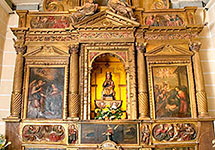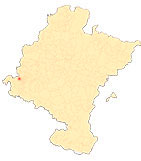Sanctuary of Nuestra Señora de Codés
By Pilar Andueza Unanua
The main altarpiece
The church is presided over by a straight altarpiece that occupies the entire chancel. It was consecrated on July 2, 1642. Its origin is located two years earlier, when Diego Jacinto Barrón was given 400 reals for its construction. If thanks to his generosity it had been possible to enlarge the church and sacristy some time before, now he was in charge of bringing from Madrid three large canvases for the altarpiece, corresponding to the Annunciation, the Assumption and the Nativity, still characterized by a linear painting although already with luminous contrasts.
The payments made in 1642 allow us to know the artists who worked on this piece of furniture and thus we know that Diego Jiménez de Castrejana, a sculptor residing in Cabredo, son of the Logroño sculptor Pedro Jiménez, trained in Valladolid with Gregorio Fernández, made the images of Saint Joseph, Saint Joaquín, Saint Isabel, Saint Anne and the two upper angels. The pedestal was executed by Jerónimo Chávarri, a sculptor also from Cabredo, while the gilding of the altarpiece was done by Diego de Arteaga, from Villava.
The altarpiece, which presents a style typical of the first half of the 17th century, is classified by professor Fernández Gracia as classicist. In it are mixed and give quotation elements from the Renaissance, such as the balanced distribution and compartmentalization of boxes and scenes, inherited from Romanesque workshops, with other Mannerist, and proto-Baroque, as seen in the wreathed columns, in the corbels, in the decorative plant motifs progressively more fleshy, or in the frames with abundant gallons.
The piece of furniture consists of a double bench on which rises a single body divided into three sections separated by wreathed columns and crowned by triangular pediments. On the side streets are the paintings of the Annunciation and the Nativity. The central box, which shelters the image of Our Lady of Codés, is topped with a good-sized pediment that invades the attic and on which rest two reclining angels that evoke the Medicean tombs of Michelangelo. The whole is topped by an attic between fins and vases that rests on a pedestal on which are placed, in pairs, the Fathers of the Western Church: St. Gregory and St. Jerome on one side, and St. Augustine and St. Ambrose on the other. Above them rises a large canvas of the Assumption between twisted columns with the lower third grooved. It is crowned by a semicircular split pediment on which stands a Crucified.
The iconography, undoubtedly Marian, also incorporates other devotions as can be seen on the bench. There, St. Catherine and St. Barbara are placed in two landscape canvases that, together with the reliefs of St. Joseph and St. Joachim, flank the tabernacle of invoice modern, located in front of a central canvas with two praying angels. On the second level of the bench there are two reliefs of landscape oval format with the evangelists, associated in pairs: St. Mark and St. John on the Gospel side, and St. Luke and St. Matthew on the Epistle side. In the center, the high reliefs of St. Elizabeth and St. Anne accompany the painting of St. Coloma, whose presence should possibly be related to the devotion to this saint in the area (Shrine of Our Lady of Fair Love in Mendaza) and in La Rioja (the town of Santa Coloma near Nájera).
AMIAX, J. de, Ramillete de Nuestra Señora de Codés, Pamplona, By Carlos Labayen, 1608.
History of Our Lady of Codés. Sencillos apuntes sobre Codés, Logroño, Cofradía Administradora del Santuario de Nuestra Señora de Codés, 1939.
ANDUEZA UNANUA, P, "El Santuario de Nuestra Señora de Codés: historia, arte y devoción", in FELONES MORRÁS, R. (coord.), En montes y valles. Santuarios en Tierra Estella, Estella, Cofradías de Nuestra Señora del Puy, Nuestra Señora de Codés y San Gregorio Ostiense, 2017, pp. 52-65.
AZANZA LÓPEZ, J. J., Arquitectura religiosa del Barroco en Navarra, Pamplona, Institución Príncipe de Viana, 1998.
GARCÍA GAINZA, M. C. and others, Catalog Monumental de Navarra. Merindad de Estella II**, Pamplona, Institución Príncipe de Viana, 1983.
ITÚRBIDE DÍAS, J., Between the Renaissance and the Baroque: Ramillete de Nuestra Señora de Codés (A bouquet of Our Lady of Codés)Piece of the month. Chair de Patrimonio y Arte navarro, 2016.
ORDOÑEZ, V., Santuario de Codés, Colección Temas de Cultura Popular nº 343, Pamplona, Diputación Foral de Navarra, 1984.











